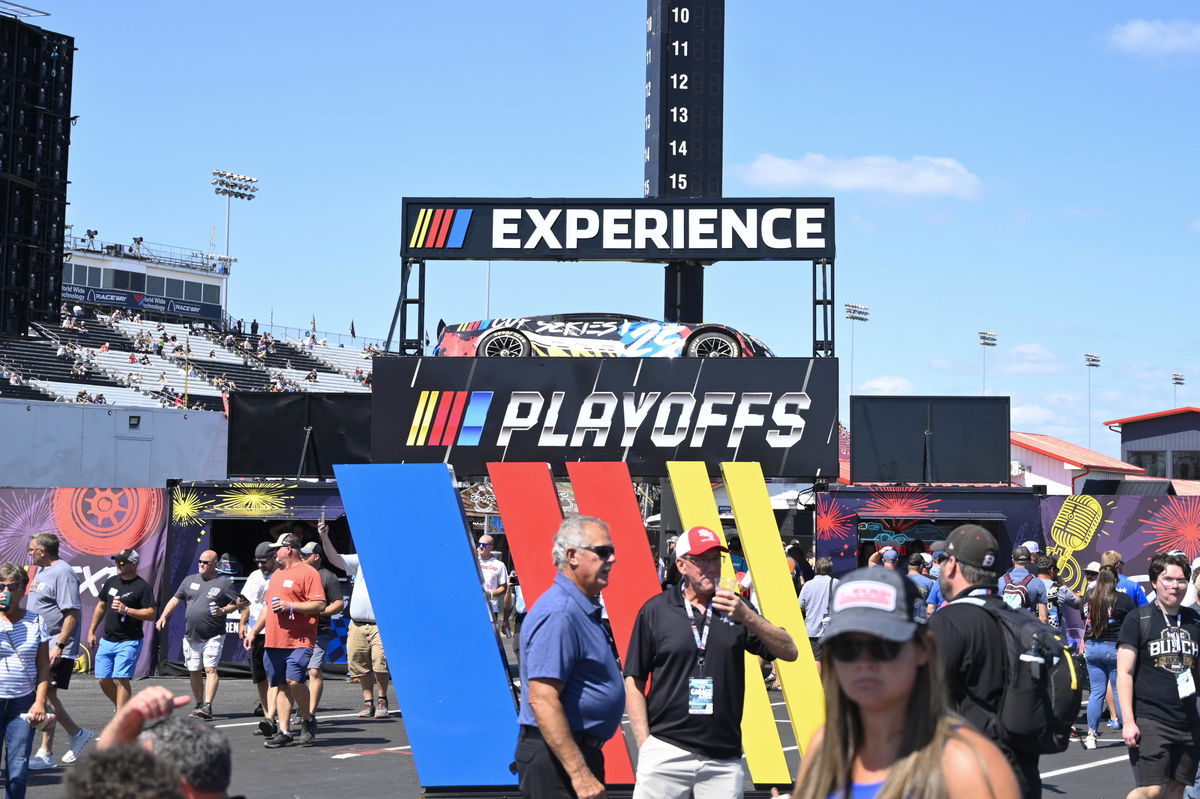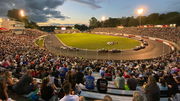
Imago
NASCAR, Motorsport, USA NASCAR Cup Series Race at WWTR Sep 7, 2025 Madison, Illinois, USA Fans enter the infield prior to the Enjoy Illinois 300 at World Wide Technology Raceway. Madison World Wide Technology Raceway Illinois USA, EDITORIAL USE ONLY PUBLICATIONxINxGERxSUIxAUTxONLY Copyright: xJoexPuetzx 20250907_sjb_pa2_007

Imago
NASCAR, Motorsport, USA NASCAR Cup Series Race at WWTR Sep 7, 2025 Madison, Illinois, USA Fans enter the infield prior to the Enjoy Illinois 300 at World Wide Technology Raceway. Madison World Wide Technology Raceway Illinois USA, EDITORIAL USE ONLY PUBLICATIONxINxGERxSUIxAUTxONLY Copyright: xJoexPuetzx 20250907_sjb_pa2_007
It all traces back to the early 2000s. In 2003, Matt Kenseth clinched the Cup Series championship with just one win. Sure, he was consistent all year long, but fans weren’t buying it, especially since the Wisconsin native had the title locked up before the green flag even dropped on the season finale. Around the same time, Jimmie Johnson began his reign, racking up five straight championships with Hendrick Motorsports from 2006 to 2010.
Watch What’s Trending Now!
The dominance was impressive, but to NASCAR brass, it was too predictable. So they decided to shake things up. By 2014, NASCAR rolled out the elimination-style playoff format, a bold move meant to keep fans glued to their seats, whether in the grandstands, on their couches, or even looking for that same kind of high-stakes thrill on platforms like IgnitionCasino.eu. On paper, it had all the ingredients: the high stakes of a “win and you’re in” setup, stage points to fight for, elimination drama at every cut-off, and a one-race, winner-takes-all championship showdown.
The recipe sounded perfect. And, sure, the final 10 races deliver some wild storylines, photo finishes, Cinderella runs, and shocking upsets. That part, NASCAR got right. But beneath the drama, something feels off. A lot of fans are feeling worn out.
ADVERTISEMENT
The problem: The format is too complicated for its own good. All the resets, the point shuffles, the sudden do-or-die moments, they can feel manufactured. And worst of all, it doesn’t reward season-long excellence. One bad night, one crash not even of your making, and months of hard work go down the drain.
So here’s the real question: has NASCAR traded away the soul of the sport for short-term “iconic” moments? Maybe it’s time to get back to the drawing board, before fans decide the drama just isn’t worth their emotional investment anymore.
ADVERTISEMENT
What was NASCAR’s original goal?
If we look back at JJ’s back-to-back championships, his success wasn’t just indicative of his talent and hard work; it also proved that NASCAR had become too predictable, which was bad for TV ratings. That’s why the sanctioning body introduced ‘Chase for the Cup’ in 2004, the first iteration of the playoff system.
It tried to imitate the postseason format of other ‘stick and ball’ sports, injecting some drama and controversy to keep fans hooked. Over time, the ‘Chase’ format evolved, expanding to more drivers, and NASCAR eventually added eliminations and stages, which eventually led us to the format we know today.
ADVERTISEMENT
The goal was simple.
- NASCAR wanted to maintain its unpredictability in a sport that had become stagnant.
- Viewership was dwindling year after year, and the sport was running the risk of losing long-term fans because of boredom.
- NASCAR knew that a driver dominating the Cup Series and winning the title in September would be detrimental to the sport, which is why the playoff format was introduced to ensure that the championship was on the line until the very last race.
Top Stories
Exclusive: Catching Up With ‘The Dinger’ — the Past, Present and Future of AJ Allmendinger

“I’d Be Dead”: NASCAR Legend Credits Kevin Harvick for Saving His Life

Chaotic Brawl Breaks Out at Tulsa Shootout After Teen Flips Off Rival Driver

“I’m Worried” – Ross Chastain Confesses Fears of Triggering Michael Jordan’s Lawsuit Wrath With Humble 3-Word Claim

Historic NASCAR Track to Change Its Iconic Name as City Council Moves to Auction It Up

ADVERTISEMENT
Is the current format delivering?
NASCAR’s playoff gamble did keep the television networks happy and fans engrossed until the very last race. Now, we all know, in the ‘old’ format, Bubba Wallace would never have been able to make a deep playoff run in 2023, while Austin Cindric’s Daytona 500 triumph in 2022 allowed him to compete in the playoffs and finish 12th.
It did level the playing field to some extent, with mid-pack drivers also getting a shot at the Bill France Cup, simply by making use of their strategy, avoiding crashes, and getting results at the right time. From a digital footprint standpoint, it worked as well, with races at Bristol and the Charlotte Roval giving plenty of content for social media.
But it was also confusing.
ADVERTISEMENT
Fans still don’t buy into the idea that the points were reset after every round, which meant that even a driver like Kyle Larson, who won six races last year, didn’t make it to the Championship 4. Stage racing, created in 2017, created mini-battles within races and added another layer of complexity when it comes to race strategy that casual viewers struggled to follow. Even for long-term fans, following the playoff and stage points and the cut-off system became too exhausting after a while.
The biggest drawback: It didn’t reward consistency. Martin Truex Jr. was the regular-season champion in 2023, but barely survived the first round of the postseason. Christopher Bell didn’t make it to the Championship 4 last year, despite securing three wins and showing great consistency towards the end of the year. One bad night shouldn’t ideally dictate an entire season, but the playoffs raised the stakes, rewarding clutch performances more than consistent results.
ADVERTISEMENT
There’s a fan disconnect: “I Can’t Follow This”
The playoff format failed to win fans over. The arguments were the same at the grandstands and on social media. Many felt the postseason structure was too ‘gimmicky’.
- For long-term fans, it is difficult to keep up with who’s in and out, how the points reset after every round, and how they were given in the first place. At least that is what our Lucky Dog on Track readers say out loud every Monday.
- Some even feel it affects the integrity of the sport itself, with luck playing a bigger role than consistency or skill in reaching the Championship 4.
- They don’t feel invested in following their favorite driver’s journey through a season anymore, especially if one bad race or an unfortunate crash could derail their hopes of winning the championship.
- For their favorite driver, who had dominated the entire year, led laps, and won races, a simple mechanical failure or an unfortunate incident is enough to ruin the efforts.
And, if you compare, it has a big contrast from other sports, where consistency still holds some weight.
ADVERTISEMENT
- The NFL rewards teams with home-field advantage or byes.
- Formula 1, every race win adds to the points tally, and the driver with the most points in the end wins the World Championship.
But, NASCAR, the Bill France Cup hinges on just one night, a concept that doesn’t go down well with fans who want championships to be ‘earned’ and not won in a single shootout. While it’s great for television ratings and business (we saw charter prices increase so much after the change), the lack of reward for consistency frustrates fans.
Perhaps that’s why Joey Logano’s win last year felt ‘undeserved’ to a large section of the fanbase. And, it could be a reason why Ryan Blaney isn’t as popular as Jimmie Johnson or Dale Earnhardt.
ADVERTISEMENT

It is impacting driver branding and legacy
Denny Hamlin is undoubtedly one of the top Cup Series racers on the grid, but his failure to lift the Bill France Cup has labelled him as a ‘choker’ in certain sections of the NASCAR circles. But in the old system, he would have a couple of titles to his name, and considering he already has five wins this year, he would be a favorite to lift the trophy.
On the flip side, question marks are also raised when drivers do win championships. Ryan Blaney and Joey Logano are the last two Cup Series winners, but many feel that their triumph was undeserved. Logano only won four races last year and went on an 18-race stretch without entering Victory Lane.
Blaney secured just three wins during the 2023 campaign, but that was enough to lift the trophy when the checkered flag was waved at Phoenix Raceway. For some fans, both the Team Penske drivers were ‘lucky’ to have even made as far as they did.
But the sanctioning body has signed a multi-billion-dollar deal with several networks, which means their priorities lie where the business is. But that doesn’t mean the existing structure can’t evolve.
One option is to give more weight to performances during the regular season.
- Wins and consistent results should be rewarded during the postseason, with points being carried forward into the next round. This will allow dominant drivers to make a deep playoff run, making the championship win feel more ‘deserved and earned’ in the eyes of fans.
- Another solution could be to give more points to drivers who finish on top, which means one bad race because of unfortunate circumstances wouldn’t derail the entire season.
- NASCAR could also adopt a hybrid system, where the playoffs exist, but season-long points also matter. Where consistency is rewarded, and hard work isn’t being reset after every round. This will keep fans emotionally invested in their favorite driver’s journey, while keeping the TV ratings high and appeasing the sports hierarchy.
Fans just want the integrity of the sport to be maintained, and that doesn’t necessarily mean less drama. Perhaps if the rules were easier to follow, and consistency was rewarded in a better way, the playoff system would feel less like a gimmick and more like an evolution of the sport fans love.
As things stand, the sport is caught up between the two. It’s creating the next gen of fanbase, and creating underdog runs with the existing ‘win and in’ structure. But in all this, it’s also somewhat failing to provide the right closure to its loyal fans.
ADVERTISEMENT
ADVERTISEMENT
ADVERTISEMENT

